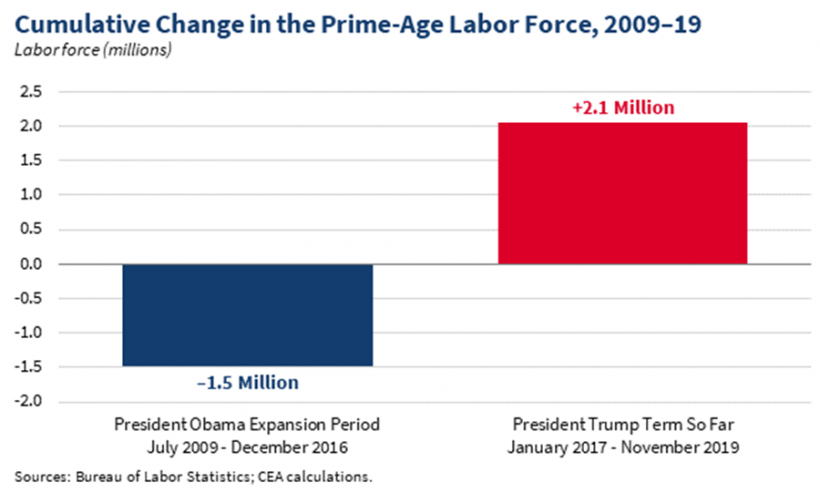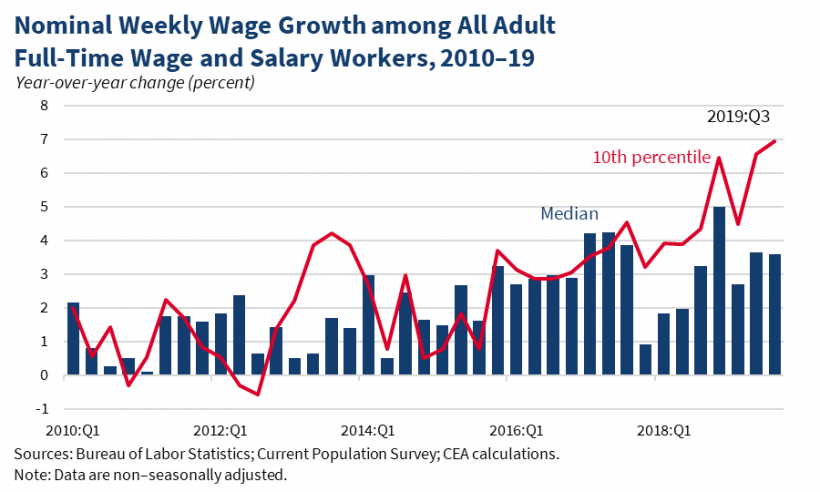Across various metrics, economic data show a U.S. labor market that is the strongest it has been in the last half-century. CEA’s new report shows that these historic labor market gains, supported by President Trump’s pro-growth economic policies, disproportionately benefit traditionally disadvantaged Americans who were previously left behind during the economic recovery. The Administration’s policies are boosting job creation, lowering structural barriers that make it more difficult for Americans to enter labor markets, and reducing income inequality. Furthermore, the report shows falling enrollment in public assistance programs, which suggests that a strong economy is much more effective than government-provided welfare at lifting Americans out of poverty.
The Trump Administration’s pro-growth policies have created a surge in labor demand, leading to the first time that there are more job openings than unemployed people since job openings data began to be collected in 2000. Openings have now outpaced unemployed people for 19 straight months. The U.S. unemployment rate continues to fall below pre-2016 election forecasts and reached 3.5 percent this year, the lowest rate in a half-century. This incredible drop in unemployment has ensured that job seekers find success, which drives the share of the population on unemployment insurance down to the lowest percentage since the 1960s. Importantly, the unemployment rate for many disadvantaged groups also reached historic lows. The African American unemployment rate hit the lowest level on record, and series lows were also achieved for Asians, Hispanics, American Indians or Alaskan Natives, veterans, those without a high school degree, and persons with disabilities, among others.
Since the 2016 election, the economy has added more than 7 million jobs, far exceeding the 1.9 million predicted by the Congressional Budget Office in its final pre-election forecast. These gains have brought Americans off the sidelines into employment, as shown in the figure below. The prime-age labor force has grown by 2.1 million people since the election, reversing losses under the prior administration’s expansion period, which totaled approximately 1.5 million people. This evidence suggests that the labor market’s revival over the past three years is not a continuation of past trends, but instead a result of President Trump’s pro-growth policies.

The Trump Administration’s policies are not only leading to more jobs, but also to higher pay. For 16 straight months, annual nominal wage growth has been at or above 3 percent, a level not reached since the Great Recession, and continues to outpace inflation. Importantly, wage growth for many disadvantaged groups is now higher than wage growth for more advantaged groups, as is the case for lower-income workers compared to higher-income workers, workers compared to managers, and African Americans compared to whites. These income gains mark a fundamental change compared to those opposite trends observed over the expansion before President Trump’s inauguration, contributing to reduced income inequality. When measured as the share of income earned by the top 20 percent, income inequality fell in 2018 by the largest amount in over a decade. The Gini coefficient, an overall measure of inequality in the population, also fell in 2018.

Employment and earnings gains continue to pull people out of poverty and means-tested welfare programs, increasing self-reliance through economic activity while decreasing reliance on government programs that incentivize people to limit their hours or stop working to qualify. The number of people in poverty decreased by 1.4 million from 2017 to 2018, and the poverty rates for blacks and Hispanics reached record lows last year. Food insecurity has fallen and, as of August 2019, there are nearly 7 million fewer people participating in the Supplemental Nutrition Assistance Program (food stamps) than at the time of the 2016 election. Additionally, the caseload for Temporary Assistance for Needy Families (TANF) fell by almost 700,000 individuals and the number of individuals on Social Security Disability Insurance has fallen by almost 380,000 since the 2016 election. Similarly, Medicaid rolls are decreasing even as the U.S. population increases. Our analysis shows that this decrease is predominantly due to a reduction in the number of Medicaid-eligible individuals because of income growth, not eligibility restrictions.
Another Administration priority is the Opportunity Zones provision created by the 2017 Tax Cuts and Jobs Act. Opportunity Zones are tax cuts designed to spur investment and drive up investment and labor demand in economically depressed areas, directly helping the disadvantaged through increased economic activity. It is a means-tested, supply-side policy to reduce poverty by enhancing self-sufficiency rather than by growing government dependency through demand-side subsidies for goods and services like healthcare, housing, and food. And there is evidence that Opportunity Zones, along with other reforms that lowered taxes on capital, are working. Indeed, lowest wage earners have seen the fastest nominal wage growth (10.6 percent) of any income group since the Tax Cuts and Jobs Act was signed.
To further accelerate these unprecedented gains for disadvantaged groups, the Trump Administration is launching several new initiatives to increase economic opportunity by removing barriers to work. Modernizing worker training will ensure that workers have the skills needed to find jobs and build careers. Reforming occupational licensing will make it easier for workers to enter certain professions where regulations go beyond what is necessary to protect consumers. Occupational licensing also makes it more difficult to move to a different State, and reform will allow more workers to move to where there are available jobs.
Additionally, those leaving incarceration or struggling with opioid addiction face barriers to finding work, which stops them from filling open jobs. And, and as highlighted in last week’s White House Summit on Child Care and Paid Leave, many parents would like to enter the labor force or work more hours but face high costs for child care. Lowering child care costs, combating the opioid crisis, and promoting job opportunities for those leaving incarceration will allow more disadvantaged individuals to enter the labor market and realize the full gains of the strong economy.
Today’s historically robust labor market helps all Americans, but the largest benefits are going to people who have been traditionally disadvantaged and were previously left behind during the economic recovery. Additional deregulatory actions targeted at remaining labor market barriers will allow the economy to add to its record-long expansion and lead to further employment and income gains, particularly for disadvantaged groups.
